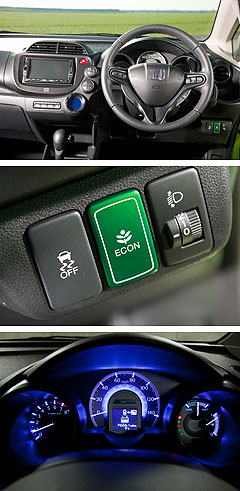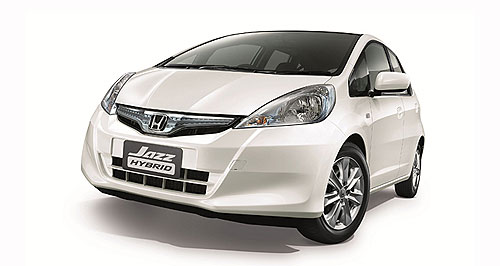Make / Model Search
Future models - Honda - Jazz - HybridSydney show: Honda set for Jazz HybridJazzed up: The petrol-electric Jazz will arrive in Australia from Thailand, which has just launched the model, and marks Honda’s first hybrid production foray outside Japan and the US. Australia prepares for Jazz Hybrid debut as Thailand kicks off sales, production20 Aug 2012 By TERRY MARTIN HONDA is gearing up to launch the hybrid version of its Jazz hatchback in the final quarter following the lean-sipping light car’s launch in Thailand late last month. Expected to make its debut at the Australian International Motor Show in Sydney on October 18, the Australian-spec model will be produced in Thailand alongside the conventional-engined version, taking advantage of the free-trade agreement between the two countries. Australian pricing and sales aspirations are being kept under wraps, although it is certain to be priced close to its nearest rival, Toyota’s Prius C, which starts from $23,990 (plus on-road costs) and is currently averaging more than 250 sales a month. Honda Motor Co has said it is aiming to sell 10,000 Jazz Hybrids in Thailand – where it starts from 768,000 Baht ($A23,224), a circa-$5300 premium over the regular petrol model – and an equivalent number in Malaysia, once production commences there next year. Its Thai production debut marks the first time the Japanese auto giant has built hybrid cars outside either its home market or the US. Having restored supply lines that were cut last year as a result of the Japanese and Thai natural disasters, Honda Australia has this year returned Jazz to a strong position with 5700 new registrations in the first seven months, which puts it on course to crack 10,000 sales for the first time since 2007.  Left: Interior of UK-spec Honda Jazz Hybrid. Left: Interior of UK-spec Honda Jazz Hybrid.While the Hybrid should bolster sales and is considered an important addition to the range, Honda – which has pioneered petrol-electric motoring in Australia – has previously acknowledged how difficult it is to sell hybrid cars in this market. Full Thai details show the Jazz Hybrid is powered by Honda’s familiar 1339cc four-cylinder i-VTEC engine that in this instance produces 65kW of power at 5800rpm and 121Nm of torque at 4500rpm, combining with a 10kW/78Nm electric motor and driving the front wheels through a continuously variable transmission. Engine idle-stop and a low-speed EV mode are fitted, helping the Hybrid deliver combined-cycle fuel consumption of 4.7L/100km and CO2 emissions of 110 grams per kilometre, based on internal company figures. This is less impressive than preliminary pre-production figures out of Japan (measured under a different regime) that indicated the Jazz Hybrid would return just 3.3L/100km and 77g/km, as well as UK specifications that hands it 104g/km and 4.5L/100km. In comparison, Toyota’s Prius C manages 3.9L/100km and 90g/km on the official Australian ADR 81/02 standard from its 54kW/110Nm 1.5-litre Atkinson-cycle petrol engine and 45kW/169Nm electric motor (delivering a total output of 74kW). The Jazz Hybrid tips the scales at 1166kg, which is around 50kg heavier than the regular Australian-spec automatic versions. While all Australian cars currently come with a full-size spare wheel, the Thai-spec Hybrid has a puncture repair kit to minimise the weight disadvantage brought with the battery pack and other extra components. The chassis set-up mirrors the conventional model, including the use of a MacPherson strut front suspension, torsion beam rear axle, electric power steering system and standard 15-inch alloy wheels. In Thailand, Honda is the first brand to offer a hybrid car in the sub-compact segment and has put a five-year/unlimited-mileage warranty on the hybrid system, including the electric motor, IPU (intelligent power unit), battery and wiring. Outside, the greenest Jazz is identified by a unique chrome grille, blue clear-lens headlights and tail-lights (both with chrome accents) and Hybrid badging, while the cabin includes an ‘Econ-Meter’ and instruments that show charging and “power enhancement” generated by the electric motor. The driver can activate an ECON switch that takes the car into “super economy” mode, resulting in a four per cent reduction in torque (except when the driver presses the pedal to the metal), smoother CVT shift pattern, increased regenerative braking and altered air-conditioning operation. The IMA system, battery pack and power control unit are located under the rear cargo floor, which according to Honda has meant no change in either seating flexibility or cargo space. It does lose underfloor storage space, but retains the maximum luggage capacity of 848 litres with the rear seats folded. Thai-spec models come with dual front airbags and ABS brakes with electronic brake-force distribution, although Australian models should add traction and stability control and curtain airbags to the mix.  Read more2nd of April 2012  Honda locks in Accord hybrid sedan for AustraliaThai-built Honda Accord to offer hybrid powertrain in next generation from 20141st of March 2012  Hybrid Honda Jazz for Australia by end of yearHonda Australia to tackle Toyota Prius C with new hybrid Jazz by year’s endAll future models Alfa Romeo Alfa Romeo Abarth Abarth Alpine Alpine Alpina Alpina Audi Audi Aston Martin Aston Martin BMW BMW Bentley Bentley Chery Chery Brabham Brabham Chrysler Chrysler Chevrolet Chevrolet Cupra Cupra Citroen Citroen DS DS Dodge Dodge Fiat Fiat Ferrari Ferrari Foton Foton Ford Ford Great Wall Great Wall FPV FPV Haval Haval GWM GWM Honda Honda Holden Holden Hummer Hummer HSV HSV Infiniti Infiniti Hyundai Hyundai Jaguar Jaguar Isuzu Isuzu Kia Kia Jeep Jeep Land Rover Land Rover Lamborghini Lamborghini Lexus Lexus LDV LDV Mahindra Mahindra Lotus Lotus Mazda Mazda Maserati Maserati Mercedes-AMG Mercedes-AMG McLaren McLaren MG MG Mercedes-Benz Mercedes-Benz Mitsubishi Mitsubishi Mini Mini Opel Opel Nissan Nissan Peugeot Peugeot Pagani Pagani Proton Proton Porsche Porsche Renault Renault Ram Ram Rover Rover Rolls-Royce Rolls-Royce Skoda Skoda Saab Saab SsangYong SsangYong Smart Smart Suzuki Suzuki Subaru Subaru Toyota Toyota Tesla Tesla Volvo VolvoJazz pricingMotor industry news |
Click to shareHonda modelsResearch Honda All future models Alfa Romeo Alfa Romeo Abarth Abarth Alpine Alpine Alpina Alpina Audi Audi Aston Martin Aston Martin BMW BMW Bentley Bentley Chery Chery Brabham Brabham Chrysler Chrysler Chevrolet Chevrolet Cupra Cupra Citroen Citroen DS DS Dodge Dodge Fiat Fiat Ferrari Ferrari Foton Foton Ford Ford Great Wall Great Wall FPV FPV Haval Haval GWM GWM Honda Honda Holden Holden Hummer Hummer HSV HSV Infiniti Infiniti Hyundai Hyundai Jaguar Jaguar Isuzu Isuzu Kia Kia Jeep Jeep Land Rover Land Rover Lamborghini Lamborghini Lexus Lexus LDV LDV Mahindra Mahindra Lotus Lotus Mazda Mazda Maserati Maserati Mercedes-AMG Mercedes-AMG McLaren McLaren MG MG Mercedes-Benz Mercedes-Benz Mitsubishi Mitsubishi Mini Mini Opel Opel Nissan Nissan Peugeot Peugeot Pagani Pagani Proton Proton Porsche Porsche Renault Renault Ram Ram Rover Rover Rolls-Royce Rolls-Royce Skoda Skoda Saab Saab SsangYong SsangYong Smart Smart Suzuki Suzuki Subaru Subaru Toyota Toyota Tesla Tesla Volvo VolvoJazz pricingMotor industry news |











Facebook Twitter Instagram